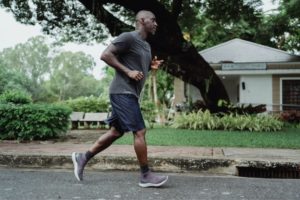Hernia is a pretty common condition, especially among people who exercise.
While suffering from hernia, it can be challenging to continue living an active lifestyle.

People with this condition would frequently ask if it’s safe to exercise with a hernia.
In this article, we’ll inform you of the best exercises to engage in as recommended by physical therapists.
What to Do If You Have Inguinal Hernia?
Inguinal hernia is a type of hernia that occurs in the groin area.
Here, soft tissue, usually part of the intestine, protrudes through a weak point or tear in the abdominal muscles.
Hernias do not heal on their own. Therefore, early intervention will prevent your symptoms from getting worse.
An inguinal hernia on its own isn’t always dangerous.
However, if left untreated, it could lead to life-threatening complications such as hernia obstruction and strangulation, or tissue damage.
If the hernia is causing significant pain, or discomfort disrupting daily activities, surgery may be necessary to prevent further complications.
However, in some cases, a small, asymptomatic hernia may not require surgery. It can be monitored through regular checkups with a healthcare provider.
The first thing to do is to consult with a healthcare professional to know if you require surgery or not.
They can develop a safe and appropriate plan for your specific situation.
Can You Still Exercise with an Inguinal Hernia?
You don’t have to give up exercising completely. To work out safely, you need to know which exercises to avoid.
While some exercises should be avoided, other exercises can be beneficial.
Exercising with an inguinal hernia is generally not recommended until after it has been repaired through surgery.
This is because of the strain and pressure that exercise places on the abdominal wall.
It’s important to avoid certain exercises that can put undue strain on the affected area and potentially worsen your condition.
What Exercise Can Aid Your Recovery from Inguinal Hernia?
There are various precautions you can take even before your operation to hasten your recovery without worsening your hernia.
First, if you have been diagnosed with an inguinal hernia, you should consult with a healthcare professional.
Do this before starting any exercise program. Depending on the severity of your hernia, certain exercises may be struck out or may need to be modified.
These exercises can help to strengthen muscles and also decrease your symptoms. They also allow you to exercise safely before surgery.
Improve Your Cardio-Respiratory Health
You can do this with exercises like walking or cycling. Walking is a low-impact exercise.
It can help improve cardiovascular health and strengthen the muscles in your legs and core.
However, avoid walking long distances or on uneven terrain, which may exacerbate the hernia.
Also, avoid cycling on steep inclines, which may put too much strain on the hernia.

Strengthen Your Limbs
Doing lightweight work out in the gym or even at home can strengthen your limbs. Don’t forget to take adequate rest for muscle recovery and repair.
Exercises to Avoid
Following hernia surgery, it can take up to 12 weeks before you can resume your typical activities.
It is best to start with modest workouts and build up to more repetitions once you’re able to.
If you have been diagnosed with an inguinal hernia. Here are some exercises to avoid:
Any Exercise with Heavy Lifting or Exertion
This includes weightlifting, squats, deadlifts, and other exercises that require you to lift heavy weights.
These activities put a lot of pressure on the abdominal muscles, which worsens hernia.
Other High-Impact Activities
Activities that involve a lot of jumping or sudden movements can also put a strain on the abdominal muscles.
This includes running, jumping jacks, or high-impact aerobics and contact sports.
Core Exercises
Exercises like sit-ups or crunches target your core. They put a lot of pressure on the abdominal muscles and can worsen the hernia.
Leg Lifts or Flutter Kicks
With leg lifts, you’re lifting your legs off the ground while lying on your back. This can put a strain on the abdominal muscles.
Twisting Exercises
Exercises that involve twisting your torso, such as Russian twists or bicycle crunches. These exercises also put pressure on the abdominal muscles.
How Do I Exercise Safely While Recovering from Hernia
Mostly, professionals would recommend low-impact exercises.
Here are some alternative exercises that may be suitable for individuals with inguinal hernias. You can maximize your post-surgery recovery with them.
Deep Breathing
After having abdominal surgery, it can be uncomfortable to take deep breaths.
Hence, people often take shallow breaths, sometimes leading to an infection. Consciously take deep breaths several times a day.
You can use a pillow to support your abdomen.
Pillow Squeeze
This is a simple pilates exercise you can do while lying down. You can do this by lying flat on the floor and bending your knees, squishing a pillow in between them.
Walking
You have to keep moving as much as possible after having a hernia surgery. It helps with circulation and prevents blood clots. It also prevents infection.
Walk, but do not overburden yourself. Otherwise, you can do leg or ankle exercises if you’re not walking enough.
Swimming
Swimming is a low-impact exercise that can be beneficial for individuals with inguinal hernias.
The buoyancy of the water can help reduce pressure on the hernia. Hence, it is a good option for those with mild to moderate hernias.
Yoga and Stretching

There’s evidence that yoga can help with or speed up the healing process after hernia surgery. It also reduces the chance of recurrence.
Yoga can help improve flexibility, balance, and core strength, which can be beneficial for individuals with inguinal hernias.
However, it is important to avoid poses that require straining or overstretching your abdominal wall. Poses such as upward dog position in yoga or twists.
Resistance Band Exercises
Resistance band exercises can still be a good option for individuals with inguinal hernias.
They allow you to control the amount of resistance and avoid putting too much strain on the abdomen.
Exercises such as seated rows, bicep curls, and tricep extensions can help strengthen the muscles in your upper body.
NOTE:
Ensure you’re doing these exercises safely to prevent counterintuitive reactions.
How to Avoid Recurrence of Hernia While Exercising
- Warm up first: Shoulder rotation, arms rotation, waist rotation, spot jogging, ankle rotation, and so on.
- Lift the appropriate amount of weight: If you do lift weights, make sure to use the proper form. Start with lighter weights before gradually lifting your way up.
- Avoid rushing and lift the weight slowly.
- Strengthen your core: Building strong abdominal and back muscles can help support the area around the hernia. This would reduce the risk of it coming back.
- Wear supportive gear: A hernia belt or compression shorts would support the area around the hernia and reduce the risk of it coming back.
- Lastly, stop exercising if you feel pain.
Key Takeaways
Exercising with hernia is risky, so you should get treated first before getting active again. See your healthcare professional before starting any exercise program.
A professional can evaluate the individual case and recommend the most appropriate course of action.
Also, listen to your body to avoid aggravating your hernia.
While looking for an alternative exercise as you recover from your hernia, the main thing is to avoid strenuous exercises.

Some people collect expensive old cars, and I’m into collecting bikes. I have 15 different bikes: special mountain bikes, sportbikes, professional, amateur, and city bikes. My friends and colleagues call me a ‘bike expert’ because I give advice on how to choose the right bike.
I’m also a massive fan of gym culture and heavyweight workouts. I met Alan at my local gym, and we’ve become friends quite soon. His idea of starting a sports blog seemed interesting to me, so I agreed to help.





